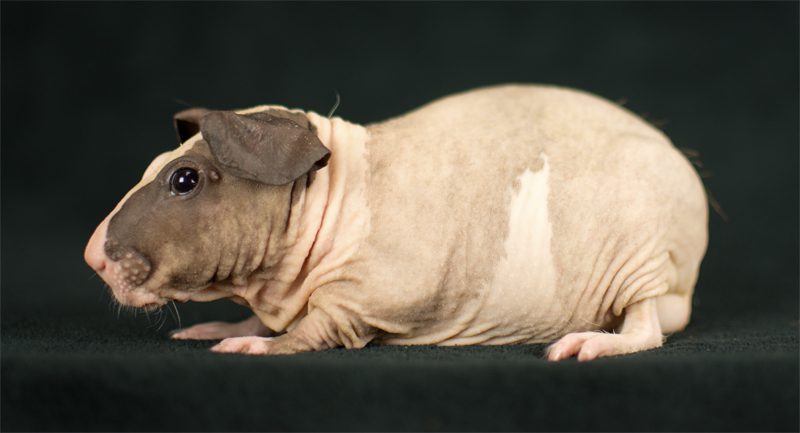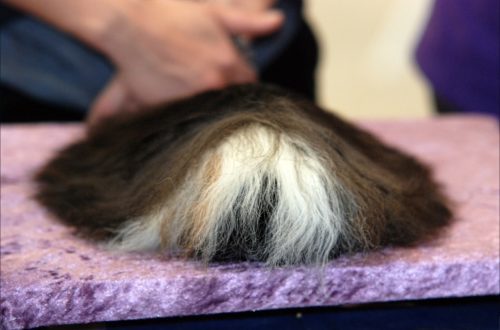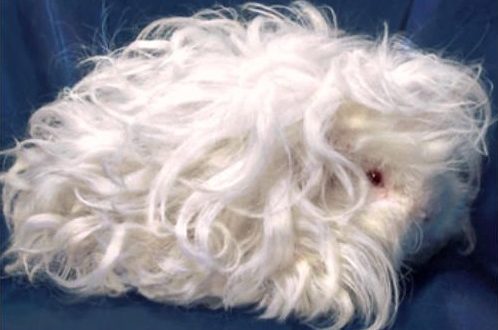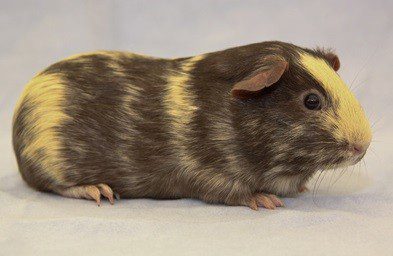
Guinea pig Baldwin
Interesting fact: Baldwin guinea pigs are born hairy, however, a few days after birth, their hair begins to fall out, and disappear completely within a few months, leaving the animal completely bald.
Interesting fact: Baldwin guinea pigs are born hairy, however, a few days after birth, their hair begins to fall out, and disappear completely within a few months, leaving the animal completely bald.

The Baldwin guinea pig is a type of hairless (hairless) guinea pig.
Baldwin is a new, recently bred breed that has already received official recognition in some countries and has found its admirers around the world.
Contrary to popular belief, in fact, Baldwins are no different in terms of physiology from their hairy relatives. They are completely immunocompetent, which means they have a healthy immune system.
They are also very energetic and each has its own character. Like other guinea pigs, they are very sociable and need your love, attention and affection. They love to be picked up and stroked, or put on their knees.
The Baldwin guinea pig is a type of hairless (hairless) guinea pig.
Baldwin is a new, recently bred breed that has already received official recognition in some countries and has found its admirers around the world.
Contrary to popular belief, in fact, Baldwins are no different in terms of physiology from their hairy relatives. They are completely immunocompetent, which means they have a healthy immune system.
They are also very energetic and each has its own character. Like other guinea pigs, they are very sociable and need your love, attention and affection. They love to be picked up and stroked, or put on their knees.
Contents
Features of Baldwin pigs
Baldwins are very different from “woolen” pigs and even from skinnies that are very similar to them. They have no hair at all, neither on the face nor on the body. Skinny pigs have fur on their noses and on their paws. At the same time, the skin of the Baldwins is elastic and, as it were, rubber, since there are not even rudiments of hair in the thickness of the skin. A feature noted by those who held this miracle in their hands is a very hot body and contrastingly cold skin on the nose.
Surprisingly, Baldwins are born covered in hair. However, a few days after birth, their hair begins to fall out, starting from the head, and continues to fall out for several months until the gilt becomes completely bald. Usually, the process of hair loss is completely completed by the time the pig reaches the age of two months.
Thus, all adult Baldwins are completely bald. Since Baldioons as a breed are descended from Crested guinea pigs, they have wrinkles and folds on the shoulders and head where a crest could be (a crest is a distinctive feature of Crested guinea pigs).
Since hairless pigs do not have proper thermal protection in the form of fur, they need especially reverent care. Both Baldwins and Skinnies are sensitive to changes in temperature. They should be kept indoors at a temperature of 20-26°C. They should also not be exposed to direct sunlight or extremely low or high temperatures. Ambient temperatures above 29°C may cause thermal shock.
Hairless guinea pigs are particularly prone to skin damage in the form of cuts and scrapes. To prevent injuries, it is necessary to provide additional “bedding” for Baldwins and regularly arrange “manicure and pedicure” procedures for your pet.
Since, due to their physiological characteristics, Baldwins require a little more care than some other breeds of guinea pigs (the same American, Teddy, etc.), they are not recommended to be bought as pets for young children. Older children, from 13-14 years old, will already be able to provide proper care for such a pig.
Baldwins are very different from “woolen” pigs and even from skinnies that are very similar to them. They have no hair at all, neither on the face nor on the body. Skinny pigs have fur on their noses and on their paws. At the same time, the skin of the Baldwins is elastic and, as it were, rubber, since there are not even rudiments of hair in the thickness of the skin. A feature noted by those who held this miracle in their hands is a very hot body and contrastingly cold skin on the nose.
Surprisingly, Baldwins are born covered in hair. However, a few days after birth, their hair begins to fall out, starting from the head, and continues to fall out for several months until the gilt becomes completely bald. Usually, the process of hair loss is completely completed by the time the pig reaches the age of two months.
Thus, all adult Baldwins are completely bald. Since Baldioons as a breed are descended from Crested guinea pigs, they have wrinkles and folds on the shoulders and head where a crest could be (a crest is a distinctive feature of Crested guinea pigs).
Since hairless pigs do not have proper thermal protection in the form of fur, they need especially reverent care. Both Baldwins and Skinnies are sensitive to changes in temperature. They should be kept indoors at a temperature of 20-26°C. They should also not be exposed to direct sunlight or extremely low or high temperatures. Ambient temperatures above 29°C may cause thermal shock.
Hairless guinea pigs are particularly prone to skin damage in the form of cuts and scrapes. To prevent injuries, it is necessary to provide additional “bedding” for Baldwins and regularly arrange “manicure and pedicure” procedures for your pet.
Since, due to their physiological characteristics, Baldwins require a little more care than some other breeds of guinea pigs (the same American, Teddy, etc.), they are not recommended to be bought as pets for young children. Older children, from 13-14 years old, will already be able to provide proper care for such a pig.
From the history of the Baldwins
The Baldwin breed appeared relatively recently (in 1978) and was the result of a spontaneous recessive genetic mutation. The progenitor of the Baldwins was born in California. Crested white guinea pig breeder Carol Miller discovered this unusual baby, thanks to which the world now knows about the Baldwin breed. Mutant genotype: hrhr.
For several years, they tried to obtain such pigs in the laboratory, and in 1982, Charles River Laboratories in the USA managed to obtain the first offspring of completely hairless guinea pigs for dermatological research. The new breed had an absolutely healthy immune system, which was the best suited for scientific research.
Today, Baldwins are just as used as experimental animals as they used to be, but they are now still bred as pets. They are loved by many families around the world.
The Baldwin breed appeared relatively recently (in 1978) and was the result of a spontaneous recessive genetic mutation. The progenitor of the Baldwins was born in California. Crested white guinea pig breeder Carol Miller discovered this unusual baby, thanks to which the world now knows about the Baldwin breed. Mutant genotype: hrhr.
For several years, they tried to obtain such pigs in the laboratory, and in 1982, Charles River Laboratories in the USA managed to obtain the first offspring of completely hairless guinea pigs for dermatological research. The new breed had an absolutely healthy immune system, which was the best suited for scientific research.
Today, Baldwins are just as used as experimental animals as they used to be, but they are now still bred as pets. They are loved by many families around the world.
What is the difference between Baldwin and Skinny
There are two types of hairless (bald) guinea pigs – baldwin and skinny. Baldwins are completely hairless guinea pigs, skinnies have tufts of curly hair on their paws and muzzles, sometimes on their backs and on the rest of the body.
There are two types of hairless (bald) guinea pigs – baldwin and skinny. Baldwins are completely hairless guinea pigs, skinnies have tufts of curly hair on their paws and muzzles, sometimes on their backs and on the rest of the body.
Baldwin color
Although the color of guinea pigs always refers to the color of the coat, and Baldwins, in principle, do not have it, all the same, such a characteristic as color can also be applied to these pigs. The color of the Baldwins shows up on their skin. Baldwins come in a variety of colors, both solid colors and various color combinations of white, pink black, brown, and more. They come in a variety of color patterns, including Dutch, tortoiseshell, and Himalayan.
Although the color of guinea pigs always refers to the color of the coat, and Baldwins, in principle, do not have it, all the same, such a characteristic as color can also be applied to these pigs. The color of the Baldwins shows up on their skin. Baldwins come in a variety of colors, both solid colors and various color combinations of white, pink black, brown, and more. They come in a variety of color patterns, including Dutch, tortoiseshell, and Himalayan.
Care and maintenance of the Baldwins
Baldwin pigs will be a bit more difficult to care for than other guinea pigs. This is primarily due to the lack of wool. Although Baldwins are quite hardy creatures, they are not able to cope with cold and too high temperatures. Also, direct sunlight is a danger to such pigs, a shadow is preferable for them. They are afraid of drafts, and can catch a cold. In a word, Baldwin, he is like a baby, requires optimal conditions and constant care.
The optimum ambient temperature for such pigs is +22 – +23°C. Fluctuations within +20 – +26°С are permissible. Anything below or above these values will be uncomfortable for the Baldwin.
The Baldwin Cage
Like other guinea pigs, Baldwins need a spacious cage, with an area of at least (0,6 square meters, or 100×60 cm). More about the cage – in the article “Guinea pig cage”
Also, don’t laugh, but you’ll still need bedding to keep your pig soft and warm. After all, Baldwin’s skin is delicate, prone to scratches and cuts, so you should avoid coarse sawdust and fillers, shavings, thick stalks of dry hay, etc. Caring owners buy soft sofas or special sleeping bags for their gentle pets. These accessories often get dirty, so it’s a good idea to have a few replacements.
What to feed Baldwins?
The body temperature of the Baldwins is always elevated, as is the metabolic rate. Hence – a higher need for food and water than other breeds of guinea pigs. Be prepared for this.
In general, all guinea pigs eat a lot (almost constantly) due to the structural features of the digestive tract. Food is poorly absorbed by them, therefore, in order to provide enough nutrients for life, pigs are constantly crunching something. That is why they should always have a supply of hay in the cage.
Baldwins are just as vegetarian as other guinea pigs. Their diet includes fresh vegetables and fruits, fresh grass or hay, special pellets and clean drinking water.
Should Baldwins be bathed?
There is no definite answer to this question. Some owners do not bathe Baldwins, but wipe them with baby wipes as needed, arguing that Baldwins’ skin is already too dry and shampoo and water will dry it out even more.
Others insist that bathing is essential for these pigs, as their skin gets dirty quickly, and bathing once every 1-2 weeks (but only with special shampoo!) Is a common thing for Baldwins.
Can Baldwins be let out on the street? They can be let out in the summer if the air temperature is between +20 – +26 ° C, but under constant supervision, and, of course, not in the sun.
You should carefully choose a place for a walk. It is best if it is a lawn with soft grass or a lawn. It is necessary to ensure that there are no sticks or sharp objects nearby that can scratch the delicate skin of a Baldwin pig.
Baldwin pigs will be a bit more difficult to care for than other guinea pigs. This is primarily due to the lack of wool. Although Baldwins are quite hardy creatures, they are not able to cope with cold and too high temperatures. Also, direct sunlight is a danger to such pigs, a shadow is preferable for them. They are afraid of drafts, and can catch a cold. In a word, Baldwin, he is like a baby, requires optimal conditions and constant care.
The optimum ambient temperature for such pigs is +22 – +23°C. Fluctuations within +20 – +26°С are permissible. Anything below or above these values will be uncomfortable for the Baldwin.
The Baldwin Cage
Like other guinea pigs, Baldwins need a spacious cage, with an area of at least (0,6 square meters, or 100×60 cm). More about the cage – in the article “Guinea pig cage”
Also, don’t laugh, but you’ll still need bedding to keep your pig soft and warm. After all, Baldwin’s skin is delicate, prone to scratches and cuts, so you should avoid coarse sawdust and fillers, shavings, thick stalks of dry hay, etc. Caring owners buy soft sofas or special sleeping bags for their gentle pets. These accessories often get dirty, so it’s a good idea to have a few replacements.
What to feed Baldwins?
The body temperature of the Baldwins is always elevated, as is the metabolic rate. Hence – a higher need for food and water than other breeds of guinea pigs. Be prepared for this.
In general, all guinea pigs eat a lot (almost constantly) due to the structural features of the digestive tract. Food is poorly absorbed by them, therefore, in order to provide enough nutrients for life, pigs are constantly crunching something. That is why they should always have a supply of hay in the cage.
Baldwins are just as vegetarian as other guinea pigs. Their diet includes fresh vegetables and fruits, fresh grass or hay, special pellets and clean drinking water.
Should Baldwins be bathed?
There is no definite answer to this question. Some owners do not bathe Baldwins, but wipe them with baby wipes as needed, arguing that Baldwins’ skin is already too dry and shampoo and water will dry it out even more.
Others insist that bathing is essential for these pigs, as their skin gets dirty quickly, and bathing once every 1-2 weeks (but only with special shampoo!) Is a common thing for Baldwins.
Can Baldwins be let out on the street? They can be let out in the summer if the air temperature is between +20 – +26 ° C, but under constant supervision, and, of course, not in the sun.
You should carefully choose a place for a walk. It is best if it is a lawn with soft grass or a lawn. It is necessary to ensure that there are no sticks or sharp objects nearby that can scratch the delicate skin of a Baldwin pig.
Baldwin breeding
Guinea pigs of this breed breed well.
If you cross two Baldwins, then the offspring will be hairless. But if only one of the parents is a Baldwin, and the other one is wool, then the offspring will also be wool, but with one recessive gene.
Breeding with Baldwin Carriers (carriers of the Baldwin gene):
- Baldwin + Baldwin = all Baldwin pigs
- Baldwin + “wool” pig = all piglets are baldwin carriers (carriers of the baldwin gene)
- Baldwin + Baldwincarrier = 50% Baldwin / 50% Baldwincarrier
- Baldwincarrier + Baldwincarrier = 25% Baldwin / 50% Baldwincarrier / 25% regular gilts
- Baldwincarrier + “woolen” pig = “woolen” pigs.
Guinea pigs of this breed breed well.
If you cross two Baldwins, then the offspring will be hairless. But if only one of the parents is a Baldwin, and the other one is wool, then the offspring will also be wool, but with one recessive gene.
Breeding with Baldwin Carriers (carriers of the Baldwin gene):
- Baldwin + Baldwin = all Baldwin pigs
- Baldwin + “wool” pig = all piglets are baldwin carriers (carriers of the baldwin gene)
- Baldwin + Baldwincarrier = 50% Baldwin / 50% Baldwincarrier
- Baldwincarrier + Baldwincarrier = 25% Baldwin / 50% Baldwincarrier / 25% regular gilts
- Baldwincarrier + “woolen” pig = “woolen” pigs.





